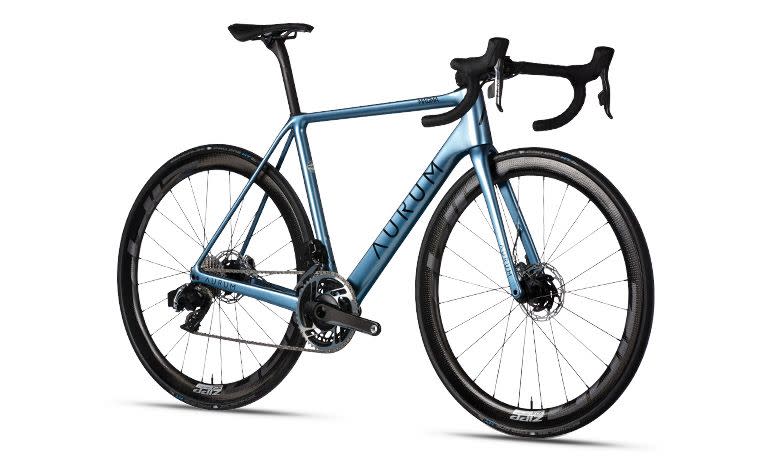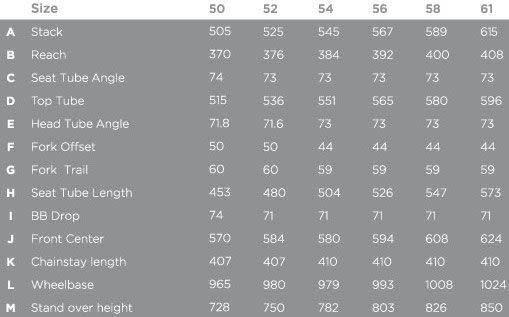Road Racing Legends Launch Aurum Bikes

Today, two road-racing legends revealed the next chapter in their careers. Aurum is the new bike brand of Alberto Contador and Ivan Basso (the two are also partners in Bend36 skincare). With nine grand tour wins between them, it’s not shocking that Aurum’s first bike is a UCI-legal road-racing bike, but a gravel bike is on the drawing board.
(If Aurum rings a bell in your skull, it is because Norco calls its downhill bike the Aurum.)

The disc-brake-only Magma cuts a clean and somewhat traditional profile. It has a level-ish top tube and standard seatstay attachment. The company claims the design’s overall goal is balance, with stiffness, weight, comfort, and aerodynamics all taken into consideration.
The resulting frame boasts an 805-gram claimed weight (54cm, unpainted), with truncated airfoil shaping (based on NACA shapes) designed in CFD and validated in the wind tunnel. Aurum did not provide aero data, however. Comfort, Aurum states, is helped by the thin seatstays and fork legs.
The bottom bracket shell follows the BB386 EVO standard—currently the widest and largest diameter standard—which helps Aurum achieve its stiffness goals by providing real estate to attach a large down tube, as well as “tall and widely spaced chainstays.”

The Magma comes in six frame sizes (50, 52, 54, 56, 58, and 61cm). Each frame size has unique tubing shapes and dimensions in an attempt to maintain the same feel and handling across the range. This tuning extends beyond the front triangle: Every frame size has a unique one-piece rear triangle. The maximum stated tire clearance is 30mm.
Though it is a modern race bike, the Magma is free of proprietary parts. It uses a round 27.2mm post (with hidden binder), the fork steerer is round with a conventional 28.6mm diameter where the stem clamps, and relatively straightforward brake-hose and derailleur-housing routing.

Brake hoses route into the front of the head tube. The front hose then routes into the fork steerer before emerging from the leg above the caliper. The rear hose travels along the down tube, around the bottom bracket, and into the chainstay. Electronic drivetrain wiring also routes into a head tube port, but mechanical drivetrain housing routes through a port on the down tube’s topside.
With electronic drivetrains, this routing system provides almost-hidden brake hoses, which reduces aerodynamic drag, without the hassle of internal bar or stem routing. That means switching bars or stems doesn’t require disconnecting and rebleeding the hydraulics. Mechanical drivetrains will produce more drag because of the exposed derailleur housing, though servicing the cables and housing is easier than a full-internal system when maintenance comes due.

The Magma’s geometry doesn’t stray much from established road-racing numbers. A size 54cm Magma’s numbers are within millimeters of a 54cm Specialized Tarmac SL7. It’s relatively long and low, with aggressive angles (parallel 73 head and seat tube angles on size 54 and up). The two smallest sizes, 50 and 52, use a 50mm-offset fork to reduce toe overlap and have 60mm of trail; the rest of the size run uses a 44mm offset fork and has 59mm of trail.
The Magma does have a less-sloping top tube than many race bikes. Compared to a 54 Tarmac SL7, the Magma’s seat tube is about two-centimeters longer (504mm vs. 475mm), which translates into taller standover (782mm VS. 768mm). The Magma has two headset cover options: 8mm for a lower position and 20mm for a more upright stance.
The Magma rolls out in two color options—Glacial Blue and Carbon Black—and three build kits. The Shimano – Enve build has Shimano’s Dura-Ace Di2 drivetrain and hydraulic disc brakes with Enve SES 3.4 disc wheels, and Enve carbon bar, stem, and seatpost. There’s also the Shimano – Lightweight build, which has the same Shimano parts but uses Lightweight Meilenstein Evo Disc TL wheels, with carbon bar, stem, and seatpost from Lightweight. The final build is SRAM – Zipp with Red eTap AXS brakes and drivetrain with Quarq power meter, Zipp 303 NSW wheels, and Zipp carbon bar, stem, and seatpost. All builds use Schwalbe Pro One 25 tires and Prologo Scratch M5 Nack saddles.
Aurum bikes are not yet available in the USA. A spokesperson said, “Availability in the U.S. is a bit later next year. Prices in U.S. dollars were not available, but in the EU, framesets sell for €4,099 (USD 4,778 at publication time) with complete bikes starting at €9,799 (USD 11,421 at publication time).
We have a review bike on order. Look for our review of the Aurum Magma soon.
You Might Also Like

